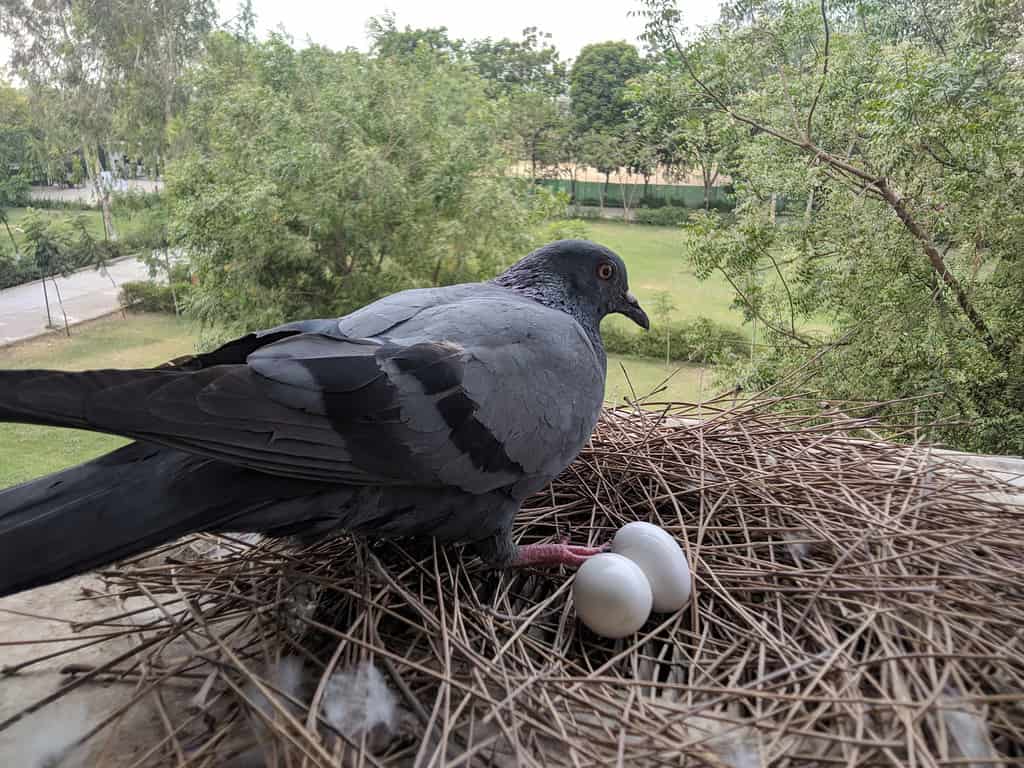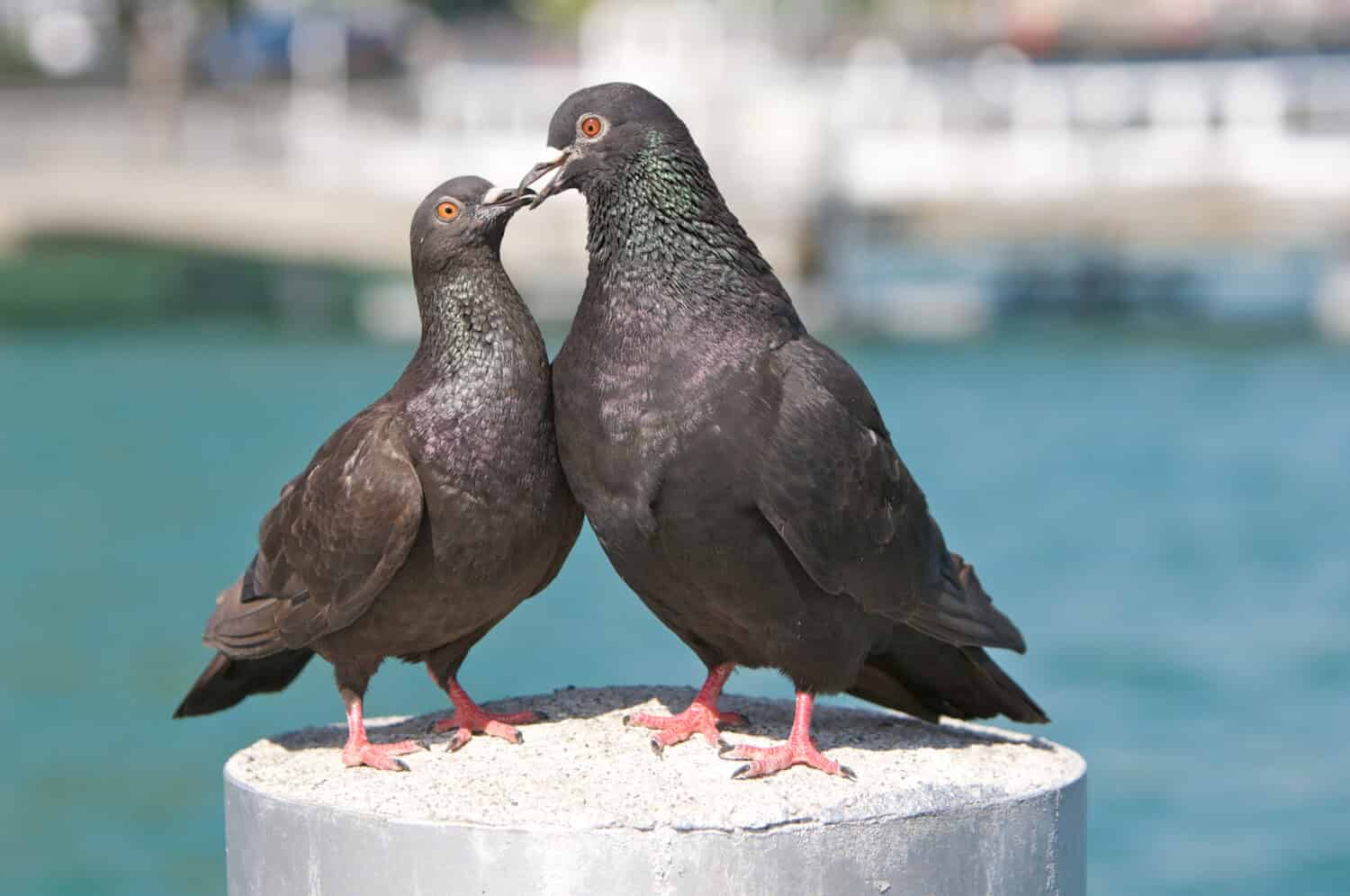Pigeons are a very common bird species found on almost every continent. Their scientific name is Columba Livia. Most of the people of the world see these common gray birdies often. But as frequently as we see the birds themselves, we might never see their nests. That is until we know where and what to look for! If you’ve ever wondered where pigeons nest, read on.
Structures That Accommodate Pigeon’s Nests

Pigeon With Egg in the nest photography. Birds Photography. Pigeon Hatching Eggs
©Fahad Puthawala/iStock via Getty Images
Pigeons like to find an out-of-the-way spot, usually high up. A bit of built-in protection from wind and the elements is a bonus, too. Natural structures like the crannies in cliffs or rock faces work well. If you’re keeping pigeons, you’ll build them a coop with shelves to which your feathered friends will adapt their nesting habits. But pigeons are one of the world’s best-adapted species when it comes to city life. Lots of human-made structures provide the framework for pigeon’s nests: eaves, gutters, construction, windowsills, vents, chimneys… There are probably hundreds of examples!
How Do Pigeons Nest?

Pigeon parents remain in the nest for several weeks to tend to their babies, known as squabs.
©ARTFULLY PHOTOGRAPHER/Shutterstock.com
Real estate is all about three things: location, location, location. A male pigeon will locate a great spot for a nest, claim it, and then coo out his mating call. He may puff out his neck and chest, bob up and down, and do a little strut to impress the ladies. If he’s a true romantic, he’ll regurgitate a snack for her. Once he’s attracted and impregnated a mate, he goes scavenging for nesting materials: sticks, straw, animal hair, or anything stem-like. Item by item, one at a time, the male presents these materials to his mate. She uses them to build a platform that will hold her eggs and keep her warm during nesting.
Pigeons will reuse their nests many times, using them to hatch up to six broods of eggs. Gross fact incoming: while many avians establish an “outhouse” beyond their nest when it’s time to, er, use the restroom, pigeons… There’s no good way to say it. They poop right in their nest. Over many broods, the nest becomes indestructible, because its walls have been coated in several layers of debris mixed with hardened pigeon guano.
Each brood will contain one to three eggs. Those eggs take around two and a half weeks to hatch, and the babies —called squabs — will remain helpless in the nest, reliant on their parents, for about a month thereafter.

Pigeons will reuse their nests many times, using them to hatch up to six broods of eggs.
©Fahad Puthawala/iStock via Getty Images
Why Do I Never See A Baby Pigeon?
Among birds, pigeons are relatively unique in that their babies stay as nestlings until they reach maturity. To put it another way, the squabs hatch and are waited on wing and foot by their parents for an entire month. Only when they are fully grown and full-sized do they leave the nest and join pigeon society. As a result, you’re unlikely to spot pigeon squabs out and about.
When Are Pigeons Most Active?
Pigeons are most likely to breed in the spring and summer, from March to July. However, pigeons can and do breed year-round.
As for when you’re most likely to see pigeons out and about? If you live in a town or city, the answer is, constantly! Larger species or those that are less adapted to human life will migrate during cold months. Other species, including avians, hibernate. But pigeons have been so hugely successful in learning to live in the corners of human life, especially human urban life — eating our discarded hot dogs, nesting in the exhaust vents of our heated buildings — they never have to stop because we never do.

The average pigeon lives to 6 years of age.
©iStock.com/Nikolay Chekalin
Which US States Have the Most Pigeons?
This one mostly comes down to which states have the most populous cities. Thanks to Manhattan, Chicago and Los Angeles, the States of New York, Illinois and California take the top prize for pigeon population. In these cities, there’s a pigeon for every two people. Paging Alfred Hitchcock…
But special mention must be made of Venice, Italy, the beautiful, slowly sinking Mediterranean city. Venice has the highest concentration of pigeons of any place on earth. Guess they just love using those gondolas for target practice!

Venice has the highest concentration of pigeons of any place on earth.
©Getty Images/DigitalVision via Getty Images
Are Pigeons Vermin?
The commonly accepted definition of “vermin” is an animal that has a large population, can be a nuisance, and spreads disease. Now, many people feel pigeons are the unofficial mascot of urban life. Some people keep pigeons as pets. Carrier pigeons even helped the Allies win World War II!
But we regret to inform you that, yes, technically, pigeons are vermin. Their numbers can spiral out of control in urban areas. Their droppings can certainly be a nuisance. And, though you probably would only contract it if you were responsible for cleaning up pigeon poo, they do carry nasty diseases such as Cryptococcosis, Histoplasmosis, and Psittacosis.
How Long Do Pigeons Live?
Feral pigeons are capable of living as long as 15 years, and there is a record of an especially well-kept pet pigeon who made it to the ripe old age of 30. However, the average pigeon’s life span is a good bit shorter than that. The average rock dove, or common pigeon, lives to be about 6.
How Large Can Pigeons Grow?
Some species of adult pigeon are less than 6 inches long. The largest are over 2 feet. The crowned pigeon is about the size of a turkey! The smallest, the Prague short-faced tumbler, would fit comfortably in your hand.
Thank you for reading! Have some feedback for us? Contact the AZ Animals editorial team.








